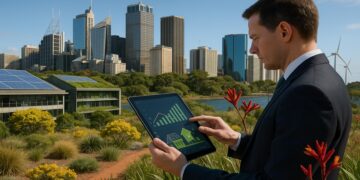Investment Trends in Green Technology in Australia: The Sustainable Future

A Shift Towards Sustainable Solutions in Australia
Australia is witnessing a remarkable transition as communities and industries embrace sustainable solutions, particularly in the realm of green technology. This movement is fueled by an increasing awareness of climate change and its impacts, pushing individuals and businesses to adopt innovative practices that prioritize sustainability. With the rising demand for clean energy and eco-friendly products, investment decisions across the nation are evolving significantly.
Factors Driving the Transition
Several key factors play a crucial role in shaping this transition towards sustainability:
- Government Initiatives: The Australian government has been proactive in promoting renewable energy sources. For example, policies that provide financial incentives for installing solar panels on homes have become commonplace. Programs such as the Renewable Energy Target aim to ensure that renewable energy constitutes a significant portion of the country’s energy production.
- Corporate Responsibility: Companies are increasingly adopting sustainable practices in response to consumer expectations. Take the example of Coles, which has committed to reducing its carbon footprint by improving energy efficiency in its stores and sourcing sustainable products. By aligning their strategies with environmental concerns, businesses not only enhance their brand reputation but also meet the demands of a conscientious consumer base.
- Technological Advancements: Innovations in energy storage and efficiency are making green technologies more attainable for everyday Australians. Consider the development of improved battery technologies, which allow homeowners to store excess solar energy for use during non-sunny periods. Companies like Tesla are leading the charge in making electric energy more viable through products like the Powerwall, which revolutionizes how households engage with energy consumption.
The Evolving Investment Landscape
The investment landscape in Australia is changing rapidly as industries focusing on sustainability gain traction:
- Renewable Energy: Solar farms and wind turbines are not just concepts but are becoming a predominant force in the energy market. The proliferation of solar farms, particularly in states like Queensland and South Australia, is a clear indication of the nation moving toward clean energy sources.
- Electric Vehicles (EVs): The rise of electric vehicles as a sustainable transportation option is gaining significant momentum. With initiatives such as Victoria’s Zero Emissions Vehicle Strategy, there is a growing infrastructure to support EV use, including charging stations and incentives for buyers.
- Waste Management: New technologies aimed at improving recycling processes and reducing waste are emerging rapidly. For example, the implementation of smart bins in major cities helps optimize waste collection and promote recycling efforts among residents.
A Bright Future Ahead
With these substantial trends, Australia is paving the way for a bright, sustainable future. The shift towards green technology presents numerous opportunities for both investors and consumers. Understanding these trends is not only beneficial for making informed investment decisions but also essential for contributing positively to a healthier planet. In embracing this sustainable revolution, we move together towards an environmentally friendly future, benefiting both the economy and the ecosystem alike.
Investment Trends Shaping Green Technology
As Australia advances towards a more sustainable future, it is witnessing a significant transformation in the investment landscape of green technology. This shift is not purely a reaction to pressing environmental issues but also acknowledges the potential profitability that sustainability-focused ventures offer. By understanding the dynamics at play, investors, businesses, and the public can better appreciate the evolving role of green technology in the economy. Here are some critical investment trends shaping this industry in Australia:
- Increased Funding for Clean Energy Projects: The surge in investment towards clean energy technologies, particularly in solar and wind energy, is remarkable. The Clean Energy Council has reported a record influx of capital into large-scale renewable energy projects in recent years. This uptrend is largely driven by the substantial decrease in technology costs, coupled with enticing government incentives aimed at promoting renewable energy adoption. For example, Western Australia and Queensland have become hotbeds for solar farms, leveraging their abundant sunlight to harness energy effectively. A specific illustration is the construction of the 100 MW solar farm in Merredin, WA, which not only contributes to local energy needs but also opens up avenues for job creation in the region.
- Emergence of Green Bonds: Another trend gaining momentum is the rise of green bonds, which have become a favored financial tool allowing companies and governments to secure funds explicitly for environmental projects. These bonds appeal to investors interested in supporting sustainable initiatives while expecting financial returns. Projects financed through green bonds often focus on renewable energy infrastructure, energy efficiency improvements, and sustainable waste management systems, reflecting a commitment to environmental responsibility. An example can be seen in the recent issuance of green bonds by the New South Wales government to fund local public transport projects that aim to reduce emissions.
- Venture Capital for Startups: There’s a noticeable increase in appetite for investments in green technology startups. Venture capital firms are actively seeking out innovative solutions that tackle sustainability challenges. For instance, startups focusing on advancements in battery storage technologies, converting waste to energy, and optimizing water management are garnering significant attention. One noteworthy example is a startup based in Sydney that has developed a pioneering method for waste-to-energy conversion, turning everyday rubbish into clean electricity, thus providing a dual benefit of waste reduction and energy generation.
- Corporate Investment in Sustainability: Established corporations in Australia are also beginning to allocate substantial resources towards investing in green technologies. Notable companies such as BHP and Rio Tinto are exploring strategies to minimise their carbon footprints while investing heavily in renewable energy initiatives. By embedding sustainability into their business frameworks, these corporations not only safeguard themselves against the risks associated with climate change but also align with the expectations of increasingly environmentally-conscious consumers.
The allure of green technology investments extends beyond mere environmental concern; it correlates with a growing recognition of the long-term economic advantages linked to sustainability. As technology progresses and regulatory frameworks evolve to favour green initiatives, the investment landscape for green technology in Australia is poised for transformative growth. This evolution will not only facilitate job creation and foster innovation but will also lead the country toward a cleaner and more sustainable future.
Community Engagement and Local Innovations
As the green technology sector in Australia continues to evolve, the role of community engagement and local innovations cannot be overlooked. Grassroots movements and public interest in sustainability are creating an environment where local initiatives thrive, which is crucial for both investment flow and practical implementation of green technologies. Here are several emerging trends reflecting this community-centric approach:
- Community Renewable Energy Projects: Across Australia, communities are increasingly taking charge of their energy needs by developing local renewable energy projects. These initiatives often operate as cooperatives, allowing residents to invest in and benefit from local solar farms or wind generation. A prime example is the Adelaide Community Energy Fund, which empowers residents to contribute to solar energy installations on public buildings. This not only generates clean energy but also fosters local job growth and enhances energy security within the community.
- Collaboration with Local Governments: Local governments are stepping up their roles as facilitators of green technology investments. Many councils now introduce policies that positively impact sustainable practices and encourage business investments in environmental initiatives. For instance, the City of Melbourne has established a Local Government Energy Efficiency Program, providing funding and support to local businesses working on energy efficiency improvements, helping them to cut costs while reducing carbon emissions.
- Education and Awareness Initiatives: A strong focus on education and awareness about green technologies is promoting informed investment decisions. Non-profit organizations and educational institutions are hosting workshops and seminars to highlight the benefits and mechanisms of green technology investments. Programs like the Australian Conservation Foundation’s initiatives are particularly noteworthy. They offer resources and information to potential investors and entrepreneurs about enterprising avenues within the sustainability sector, thereby building a knowledgeable community of investors.
- Focus on Sustainable Agriculture: The agricultural sector is also experiencing a transformation through sustainable practices and technology adoption. With Australia being a significant agricultural exporter, the push towards responsible land management and regenerative practices is vital. Investing in precision agriculture technologies not only improves crop yields but also minimizes resource waste. Innovative Australian startups are using advanced sensors and software to support farmers in making data-driven decisions, ultimately enhancing sustainability and profitability in the field.
By focusing on community involvement and local innovations, Australia is enabling a multifaceted approach to green technology investment. Emphasizing local efforts allows for a diverse range of perspectives, helps grassroots projects secure funding, and ultimately leads to more sustainable outcomes. As communities unite around green initiatives, they facilitate collaboration between the public, private, and non-profit sectors, proving that the path to sustainability is truly a collective endeavour that transcends traditional investment strategies.
Conclusion
In conclusion, the investment landscape for green technology in Australia is experiencing a dynamic transformation, driven by both market forces and community engagement. The emphasis on sustainability reflects a growing recognition of the urgent need to address climate change while simultaneously supporting economic growth and innovation. According to experts, the global shift towards sustainable practices is an opportunity for Australia to lead in the green technology arena.
Moreover, initiatives such as community renewable energy projects, collaboration with local governments, and a strong focus on education and awareness are fostering an environment ripe for investment. These grassroots efforts not only demonstrate the potential for local economies but also encourage sustainable practices that align with national and global goals. The agricultural sector’s advancement through precision technology further underscores the multifaceted nature of green investments, revealing that sustainability can enhance productivity while reducing environmental impact.
As we look towards the future, it is clear that engaging communities, leveraging local innovations, and supporting education will be vital. Investors and entrepreneurs who prioritize these aspects will not only contribute to the health of the planet but also create profitable opportunities within this burgeoning sector. Australia stands at a critical juncture—by harnessing its strengths and collaboration opportunities, it can pave the way for a greener, more sustainable future that benefits both its economy and the environment.

James Carter is a financial writer and advisor with expertise in economics, personal finance, and investment strategies. With years of experience helping individuals and businesses make complex financial decisions, James offers practical insight and analysis. His goal is to give readers the knowledge they need to achieve financial success.






